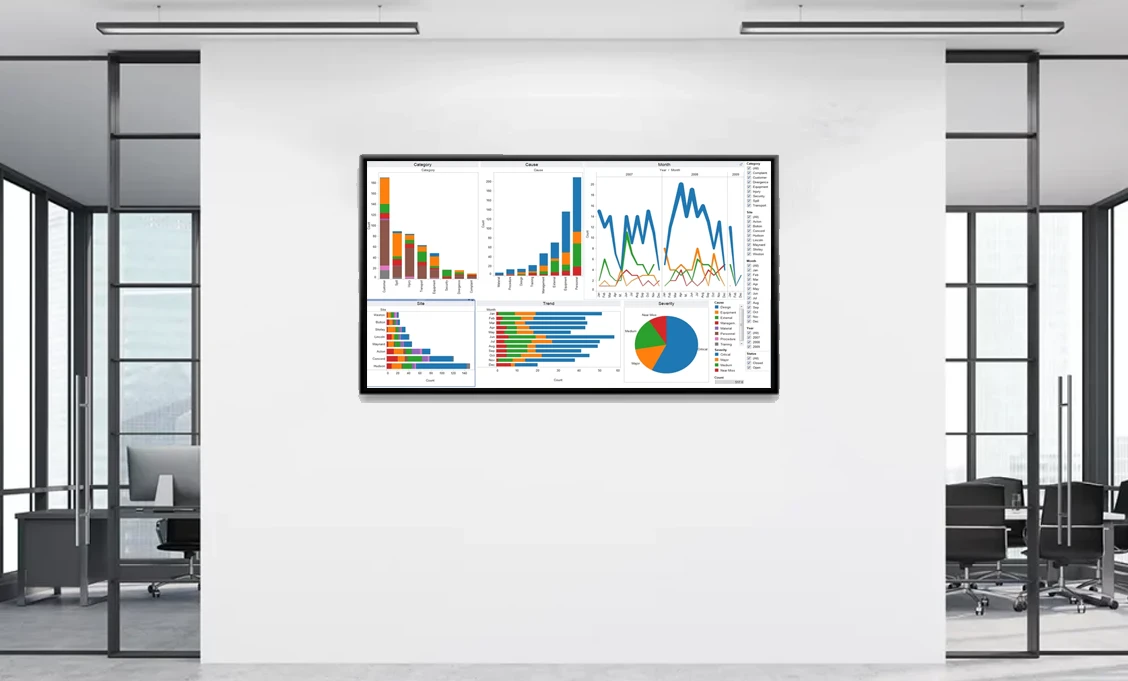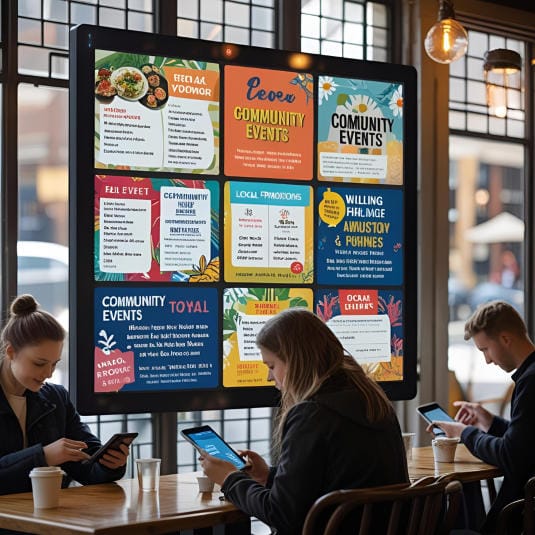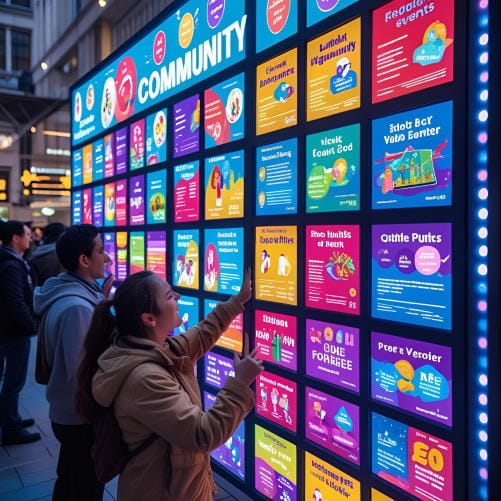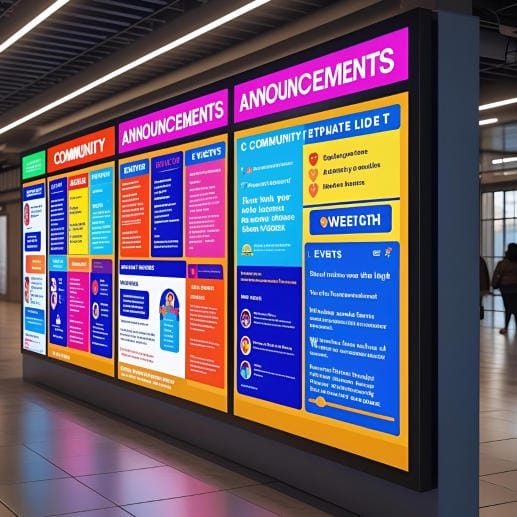Introduction
In today’s fast-paced, tech-driven world, communication within an office space has evolved significantly. Traditional corkboards and whiteboards are giving way to smarter, more interactive, and visually appealing alternatives. Enter the digital notice board — a powerful tool that helps organizations streamline internal communication, share important updates, and increase engagement. But with a multitude of options in the market, how do you choose the best digital notice board for your office? This guide will walk you through every factor you need to consider to make the best decision.
 What Is a Digital Notice Board?
What Is a Digital Notice Board?
A digital notice board is an electronic display solution used to present announcements, schedules, news, and multimedia content in a dynamic and centralized way. Unlike traditional notice boards that rely on paper and manual updates, digital boards enable real-time content changes using digital signage software.
Whether installed in reception areas, break rooms, or boardrooms, digital notice boards for offices offer seamless communication that saves time and enhances organizational transparency.
Why Offices Are Switching to Digital Notice Boards
The shift from paper-based announcements to digital platforms isn’t just a trend—it’s a necessity in a hybrid and remote-working era. Offices are switching to digital notice boards to keep their employees informed in real time. From urgent alerts and meeting reminders to celebrating team achievements, these smart boards offer unmatched flexibility and efficiency.
Key Benefits of Using a Digital Notice Board for Office
a) Real-Time Updates
Content can be updated instantly, allowing for timely communication.
b) Eco-Friendly
Reduces the need for paper and printing, supporting green initiatives.
c) Visual Appeal
Multimedia elements like videos, animations, and colorful layouts boost employee engagement.
d) Centralized Management
You can manage multiple digital notice boards from a single dashboard.
e) Improved Communication
Helps reduce communication silos, especially in larger office setups.
Types of Digital Notice Boards
a) Wall-Mounted LED/LCD Displays
The most common form of digital notice boards, perfect for lobbies and hallways.
b) Interactive Touchscreens
Great for high-traffic areas where users can explore content themselves.
c) Kiosk-Based Systems
Standalone units placed in public office areas, ideal for directories and informational content.
d) Digital Notice Boards for Home Offices
Used by remote workers to stay in sync with company updates and schedules.
e) Portable Notice Boards
Lightweight and mobile, often used in conference setups or temporary workspaces.
 Features to Look for in a Digital Notice Board
Features to Look for in a Digital Notice Board
To choose the best digital notice board for your office, consider the following features:
a) Screen Resolution
Look for Full HD or 4K resolution to ensure content is crisp and easy to read.
b) Connectivity
Wi-Fi and Ethernet options are a must for real-time updates.
c) Compatibility with Digital Signage Software
Ensure the board works seamlessly with content management systems (CMS).
d) Touch Capability
If interactivity is important, opt for a touchscreen version.
e) Content Scheduling
Choose a system that allows automated content scheduling.
f) Remote Access
Make sure the device can be managed remotely for easier updates.
g) Durability
Industrial-grade screens last longer and offer better brightness for long viewing hours.
Factors to Consider Before Buying
a) Office Size and Layout
Large offices may require multiple units; open layouts benefit more from high-visibility screens.
b) Type of Content
Text-heavy updates need different layout capabilities than multimedia-rich content.
c) Budget
Basic screens cost less, but premium models with added features can provide more value in the long run.
d) Installation & Maintenance
Consider whether you need professional installation and how easy it is to maintain the board.
e) Software Licensing
Some digital notice boards come with subscription-based software; factor this into your total cost.
 How Digital Notice Boards Compare to Traditional Boards
How Digital Notice Boards Compare to Traditional Boards
Feature | Traditional Notice Board | Digital Notice Board |
Update Time | Manual | Instant |
Content Types | Paper | Multimedia |
Eco-Friendliness | Uses paper | Paperless |
Engagement | Low | High |
Scalability | Limited | Highly scalable |
Clearly, digital notice boards outperform traditional solutions on almost every front.
Top Use Cases in Modern Workspaces
- Employee Announcements: Birthdays, milestones, achievements
- Meeting Schedules: Room bookings, updates, and reminders
- Corporate News: Internal newsletters, industry news
- Health & Safety Alerts: Emergency procedures, reminders
- Performance Dashboards: Display KPIs and team goals
- Event Promotion: Company events, training sessions
Maintenance and Content Management
Maintaining a digital notice board for office use is straightforward. With regular software updates and basic hardware checks, they remain functional for years. Content management is even easier with drag-and-drop editors offered by most digital signage software platforms.
Schedule content for specific times, manage multiple screens across various locations, and track engagement metrics — all from one dashboard.
Many modern platforms also offer AI-based content suggestions, real-time analytics, and cloud backup features.
Future-Proofing Your Investment
When choosing a digital notice board, think long-term. Look for:
- Scalable Systems: Can be expanded as your business grows.
- Software Updates: Ensure your CMS provider offers regular improvements.
- Hardware Warranty: Choose brands that offer long warranties and strong support.
- Integration: The ability to integrate with calendar apps, Slack, or email.
Making a future-proof choice ensures your digital notice board adapts to your evolving office needs.
FAQs
Q1: What size digital notice board is best for an office?
A: For small rooms, 32-43 inches works well. For large spaces like lobbies, 55 inches or larger is ideal.
Q2: Can I use a digital notice board for home?
A: Yes, digital notice boards for home are great for remote workers and family scheduling.
Q3: Is digital signage software necessary?
A: Yes, to manage and schedule content, you need compatible software.
Q4: How do digital notice boards for schools differ from office ones?
A: School boards often display class schedules, announcements, and emergency alerts, whereas office boards focus more on business communication.
Q5: Are there advantages of digital notice boards over email newsletters?
A: Yes, digital boards are visual, real-time, and ensure higher engagement compared to emails that might be missed.
Q6: How secure are digital notice boards?
A: With encrypted connections and access control, they are quite secure. Choose software that complies with security standards.
Q7: Can one manage multiple digital notice boards from one location?
A: Absolutely, most systems offer centralized dashboards for managing multiple screens.
Q8: Do digital notice boards require internet access?
A: For real-time updates and remote management, internet access is essential.


 What Is a Digital Notice Board?
What Is a Digital Notice Board? Features to Look for in a Digital Notice Board
Features to Look for in a Digital Notice Board How Digital Notice Boards Compare to Traditional Boards
How Digital Notice Boards Compare to Traditional Boards


